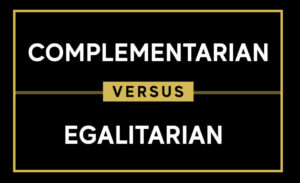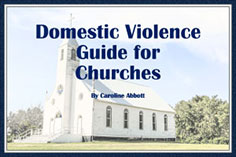
For many churchgoers, women in church leadership is a hot button. There are two major schools of thought about this, complementarianism and egalitarianism.
Complementarianism
Complementarians believe that men and women are equal in value and dignity, but different in their roles. They interpret the Bible as prescribing a complementary view of gender, and believe that the Bible teaches male headship in the family. In a complementarian marriage, the husband has the role of headship, leading the family lovingly and sacrificially. The wife supports her husband. Complementarians believe that men and women have different roles in the church, with some roles being restricted to men (usually elders and pastors).
Egalitarianism
Egalitarians agree with complementarians that men and women are equal in worth. However, egalitarianism goes further to state that men and women are considered equal in role capabilities as well; there are no gender restrictions on what roles men and women can fulfill in the church, home, and society. This view holds that the teachings and attitudes of Jesus and the New Testament abolished gender-specific roles as well as roles related to class and race.
Living out these beliefs in church can get quite sticky. I believe at their heart, most people on both sides believe this is what the Bible teaches, and they feel this is the way to have harmony and happiness in both the home and in church. Of course, people who tend to be controlling are easily able to use the complementarian view to abuse women in both churches and at home.
In my home church
I’ve had the privilege of watching my home church wrestle with whether God would have us include female elders while demonstrating love and grace to all. In our church, eldership was open only to men for the fifty plus years our church has existed. Interestingly, we did have female pastors, which is very unusual in a complementarian church. The women who were pastors were never senior pastors, but we had one female spiritual direction pastor and another female community/groups pastor. Almost two years ago, during their yearly retreat, our elders felt a movement of the Holy Spirit to explore what God wanted from our church around this issue.
Listening groups
The process they chose to take to begin making this decision was beautiful to watch. They offered forums called “listening groups” which consisted of 2 elders and 10 – 12 church goers. Each churchgoer was given the opportunity to share their thoughts and feelings around the topic. There was no debating. Each person (including the 2 elders) listened respectfully. There was a lot of silence and prayer.
In the group I joined, the views on female elders were split almost evenly between egalitarians and complementarians. Each person was firmly convinced that their point of view was correct, and that it was biblically based. When it was my turn to speak, I shared my views based on a 20 page paper I wrote while studying at Denver Seminary. Click here to see is a summary of this paper.
Lots of prayer, study and discussion
Once everyone that was interested had had a chance to speak in a listening group, the elders took many more months to pray and study this question, both individually and as a group. I am sure many in our church were impatient at the amount of time this took. I thought it was wonderful that they were seriously questioning what God wanted from them and our church as a whole. These elders read books on each side of the question, and interviewed New Testament and Old Testament professors from our nearby seminary.
Finally, a decision
Finally, about a year and a half after the question was initially brought before the congregation, they announced they had come to a decision. Rather than taking up an entire church service, they invited everyone to a mid-week evening meeting. At that meeting, our senior pastor Alex Walton shared that the elders had unanimously decided to open eldership in our church to women. I personally heaved a great sigh of relief. I know many in our church were completely dismayed, and we may lose long-time members because of this choice.
Position Paper Shared
Our pastor wrote a 27 page position paper outlining the Bible verses our elders considered while making this decision. In the mid-week meeting, he read it aloud word for word. Also several elders shared how God had changed their hearts toward including women elders. The meeting lasted a full two hours. You can access this entire meeting here. I know many of you will not want to watch this for 2 hours, or read the 27 page paper. As for me, it was one of the best 2 hours I ever spent in church. I totally geek out on things like this! To spare those of you who don’t have the time or interest, I will summarize the points made below.
Three Pillars of Biblical Study
Our elders considered three types of biblical study: narrative, direction/trajectory and exegesis. Words printed in green are taken directly from the position paper our pastor shared.
Pillar one – Narrative
Genesis
“A biblical study requires that we recognize the scriptures’ narrative movements across the whole of the canon. These large narrative sections can be succinctly categorized as Creation, Fall, Law (the old covenant), Redemption (the new covenant), and Future Renewal. We focused the majority of our study within the categories of Creation, Fall, Law, and Redemption. We wanted to see how scripture outlined both our common anthropology (humanness) and our particular genders.” The paper notes that men and women were created equally, as image bearers of God, and that women were designed to be a suitable “ezer” for man. The paper notes that “ezer” is translated as “savior” in the rest of the Bible. It notes there is no difference in roles assigned to men and women in the first two chapters of Genesis.
After the fall in Genesis 3,“the phraseology behind “your desire will be for your husband and he shall rule over you” has some semantic challenges. The Hebrew word used is “teshuqah,” meaning “passions” or “longings,” while the word for “rule” is “mashal,” meaning rule or have dominion.” This is understood as part of the curse given to Adam and Eve because of their sin. The paper notes, “The distortions came after sin, not before. The elevation of men and the subordination of women, in its most vile and most subtle forms, is a deception of the Fall, not a part of God’s good plan in creation….While a fractured relationship between men and women is evident in these passages, we do not believe they provide clear evidence that either man or woman should submit to the curse.”
The Rest of the Old Testament
Women are given two distinct leadership roles in the Old Testament. Both Miriam and Huldah are acknowledged as prophets, while Deborah is given the role of Judge. The paper notes, “We would suggest that these instances are more than women filling the role of men in the absence of male leadership but represent the surprising elevation of women in a patriarchal culture. At no point does scripture lament the absence of male leadership or authority in these situations. In fact, the fact that the speaker holding authority is female is rarely commented on, with the exception being the reference specifically to women in battle. While they are not normative, we recognize a deep significance in these roles.”
The New Testament
“Galatians chapter 3 is informative. In Galatians, Paul is dealing with issues of unity. This is the problem he is trying to solve. This potential disunity is on multiple fronts, as Paul articulates in verse 28:
26 “So in Christ Jesus you are all children of God through faith, 27 for all of you who were baptized into Christ have clothed yourselves with Christ. 28 There is neither Jew nor Gentile, neither slave nor free, nor is there male and female, for you are all one in Christ Jesus. 29 If you belong to Christ, then you are Abraham’s seed and heirs according to the promise.”
The paper notes, “A significant element often ignored in this passage is the way he moves from circumcision to Baptism as a marker of covenant. In the old covenant, only the men were sealed with the sign of the covenant. In the new covenant, all members receive the invisible marker of the Holy Spirit and the visible marker/rite of Baptism.”
Pillar Two – Direction/Trajectory
The paper outlines a trajectory of patriarchy that begins with unquestioned patriarchy in the early part of the Old Testament. Then, we see women protected from husbands that could divorce for any reason, leaving the wife destitute, (see Deuteronomy and Malachi). The paper calls this the “surprising elevation of women through moderated patriarchy.” “Jesus welcoming of women into his circle of disciples is the second trajectory movement in our study. Mary of Bethany is one who sits at Jesus’ feet (Luke 10:38f) in the pattern of first- century discipleship.” The paper calls this “the surprising elevation of women as disciples of Christ.”
“In the resurrection accounts, the seminal announcement of the Christian faith is first made by women who have found themselves included in the discipleship. A first century society did not accept women as reliable witnesses and yet the Apostles are first invited to believe because of the testimony of women!” The paper notes that three women are lauded by the Apostle Paul as apostles and disciplers (Phoebe, Priscilla and Junia). Other female leaders in the early church are: Tabitha (Acts 9:36-9:42), Lydia (Acts 16:14–15, 40), Chloe (1 Corinthians 1:11), Euodia and Syntyche (Philippians 4:2–3), Nympha (Colossians 4:15), Lois and Eunice (2 Timothy 1:5), Claudia (2 Timothy 4:21), The mother of John Mark (Acts 12:12), the “elect lady” (2 John 1:1) and Philip’s four prophet daughters (Acts 21:9).
“As we move towards God’s final redemption and follow his trajectory in scripture, we would suggest a trajectory graph looks like this:
Unquestioned patriarchy —> Surprising elevation of women through moderated patriarchy —> Surprising Elevation of Women as Disciples of Christ —> Surprising elevation of women as co-workers of Paul —> Our Work —> God’s Final Renewal”
Pillar Three – Exegesis
In exegesis, our primary task is to ask what the original listeners would have heard. This is our effort to bridge the gap between our culture and theirs. In the pastoral epistles, our job is to ask what questions the first-century churches were wrestling with and what answers they were given. We need to resist the temptation to use scripture first to ask 19th-century questions or 16th-century questions.
One passage in the New Testament has frequently been used to say women should not speak in church. I have written about this question in another blog.
1 Corinthians 14:34-35
34 Women should remain silent in the churches. They are not allowed to speak but must be in submission, as the law says. 35 If they want to inquire about something, they should ask their own husbands at home, for it is disgraceful for a woman to speak in the church.
The position paper notes that the context of these verses were that Paul was giving rules on how Christian worship should be conducted, especially in charismatic worship. The problem being addressed was that those in the Corinthian church were practicing speaking in tongues in a way that was chaotic. The paper notes that Paul cannot mean women should never speak in church, since in 1 Corinthians 11 he outlined instructions for women who were prophesying.
First, in ancient Greco-Roman culture, particularly within the less formal setting of a Corinthian house church, questions were a part of the teaching portion of a worship gathering. These were smaller groups gathered in homes, and that meant the entire experience was more like an interactive dialogue.
Two possibilities exist, both offering better context and understanding of these verses: First, perhaps ancient Mediterranean protocol would disapprove of a woman addressing men unrelated to her, hindering the church’s external witness about which Paul is concerned. Secondly, the regular denial of education to women in the first century could mean that the questioner lacked a fundamental knowledge of the subject matter being taught, hindering the church’s internal edification, which Paul is concerned about. We are fortunate to live in a society and period in which women are regularly more educated than men.
1 Timothy 2:11-12
11 A woman should learn in quietness and full submission. 12 I do not permit a woman to teach or to assume authority over a man; she must be quiet.
1 Timothy 2:11-15 has been the sheet anchor for people arguing women should not be ordained or hold the position of elder. It is a difficult passage to translate and, because of its translation history over the past 100 years, is overly susceptible to being used as a silver bullet by those who sit on the conservative side of this conversation.
Basically, the position paper views this through the lens of what was happening in Ephesus at the time. Ephesus was the center of worship for the female “god” Artemis. Worship of this god was a female-only cult. Paul here is resisting the cultural norms of this female-only cult.
1 Timothy 3:1-7
1 Here is a trustworthy saying: Whoever aspires to be an overseer desires a noble task. 2 Now the overseer is to be above reproach, faithful to his wife, temperate, self-controlled, respectable, hospitable, able to teach, 3not given to drunkenness, not violent but gentle, not quarrelsome, not a lover of money. 4 He must manage his own family well and see that his children obey him, and he must do so in a manner worthy of full[a] respect. 5 (If anyone does not know how to manage his own family, how can he take care of God’s church?) 6 He must not be a recent convert, or he may become conceited and fall under the same judgment as the devil. 7 He must also have a good reputation with outsiders, so that he will not fall into disgrace and into the devil’s trap.
This passage has been used to keep women out of eldership, because a woman cannot be a “husband of one wife,” The position paper notes however that:
Paul’s language is typical of the day. Neither Greek nor Hebrew has a word used for spouse. The very writing of an instruction to faithfulness requires choosing, as a language construct, either a man or a woman to be faithful and the other for them to be faithful to. Paul picks the gender normative pattern. This pattern exists in much of scripture. The Ten Commandments are written, semantically, to men. The pastoral epistles are directed to “brothers.” Does this mean that women are not bound to obey these scriptures as authoritative words because they are not specifically addressed to their gender? Absolutely not. They are included in the family of faith and bound to obey even when their gender is not specified. To make the assumption, therefore, that Paul excludes women because he uses masculine language is not a good argument for male-only leadership and can only be applied consistently or not at all.
In Summary
If you are interested in delving deeper into these scriptures, I again invite you to read the entire position paper. I have done my best to summarize the main points, and have already made this blog longer than I intended. I hope that God will use this blog to open up its readers to the possibility that Bible verses have been taken out of context around the question of women in church leadership.
May God bless each of you!
Caroline


